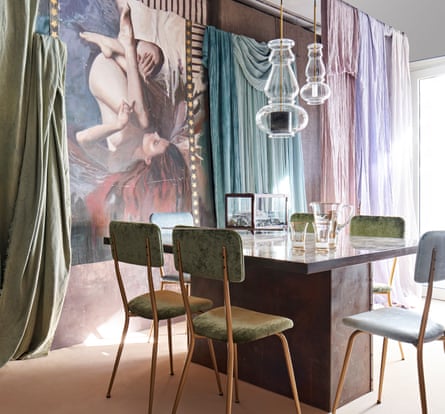
There aren’t many people who would see potential in a sprawling industrial warehouse filled with water pipes and various other industrial paraphernalia mere metres from the Adriatic coastline. But interior designer Eva Germani has a vivid imagination and, she says, “an innate attraction for imperfection”.
The 50-year-old designer came across the cavernous property one day in 2019, while walking in the seaside town of Riccione where she grew up. “I found myself disarmed in front of an uninteresting space,” she explains. “Since I was a child, I dreamed of living in decadent or poetic historic buildings.” The one standing before her had “no history and this area is not known for buildings of architectural or historical value” but she was undeterred.
The warehouse is situated on the lesser known, but increasingly popular, Romagnola Riviera. When the blistering temperatures that attract tourists from all over the world subside in September, this tourist enclave turns into a tranquil corner of Italy. “Living near the sea gives you the great privilege of always feeling a bit on vacation, like a tourist and that’s a feeling I really like,” says Germani.
Faced with a blank canvas, she and her children, Francesca, 27, and Davide, 19, set about a six-month restoration to turn the container into an open-plan, home-cum-design studio and they turned their attentions to filling it with her personality and plenty of colour.
. Francesca praises her mother’s pursuit of beauty in the least expected of settings: “For me it’s completely normal to grow up surrounded by very big concepts and artistic curations,” she says. “Beauty as a concept is often missing in the reality of the real world.”
In a stroke of serendipity, permission to turn the building from a commercial premises into a residential dwelling had already been granted, avoiding the lengthy – and often bureaucratic – application process to do so. All the planning thereafter was straightforward, says Germani.

“It was a very flexible and open space and so offered the chance to be interpreted in a flexible way – that’s why I chose it,” says Germani.
Reclaimed Italian door frames have been drafted in to form entrances and facades of cupboards and storage areas; chandeliers – reworked with recycled crystals and coloured resins by Petralux – descend from the ceilings to shed light and imbue a sense of grandeur. Meanwhile, in a stroke of genius, the dividing walls are actually not walls at all, but panels hooked to iron bars that hang from the ceiling.
“It allows us to completely change the space with the greatest of ease,” says Germani. “Each ‘room’ can expand and shrink, changing their purpose in moments.” Case in point, she laughs, the area that they call the dining room was transformed the previous week with a large flock of birds that Francesca, a scenographer and costume designer, was making for her latest movie.
The only defined spaces are the luxurious bathroom, complete with an antique roll-top bath (surrounded by Germani’s handpainted curtains) and the kitchen, furnished with vintage units, from where the family cook up pasta and locally caught fish.
The walls are collaged with lavish handpainted artwork, draped materials and wall coverings that Germani has designed. The huge tiger with a halo is from a prototype for the Wonder wallpaper she designed for Wall & Decò; the portrait of a woman is a painting in tempura and natural pigments on scenography paper taken from a photographic work by Vivienne Bellini; and the dreamy florals riff on her Niveum graphic that won a 2019 German Design Award.
Germani’s approach to furniture is akin to “falling in love”, she says. “I think I’m very nostalgic, it moves me to see objects of the past.” Many of the pieces that are here have been collected for years, from prototypes, such as the Renzo Serafini lamps to one-of-a-kind treasures from flea markets. She has also collected trophy pieces, such as the metal coffee tables sourced from her friend Francesca Orsi of L’Orangerie.
It’s an interchangeable, constantly morphing space. The door frames propped up against the walls are frequently whipped out to be used in a shoot or on a set. “They are all a part of my life and also my work,” she says.
It’s a home that is, without question, a living, breathing portfolio of the family’s inventive spirit. “It’s not refined like a home and it’s still a work in progress, but we don’t feel the need to define every corner and detail.”
Perfect imperfection like this is rarely defined – and is all the better for it.



